TOYOTA COROLLA 2020 Owners Manual (in English)
Manufacturer: TOYOTA, Model Year: 2020, Model line: COROLLA, Model: TOYOTA COROLLA 2020Pages: 588, PDF Size: 13.49 MB
Page 231 of 588
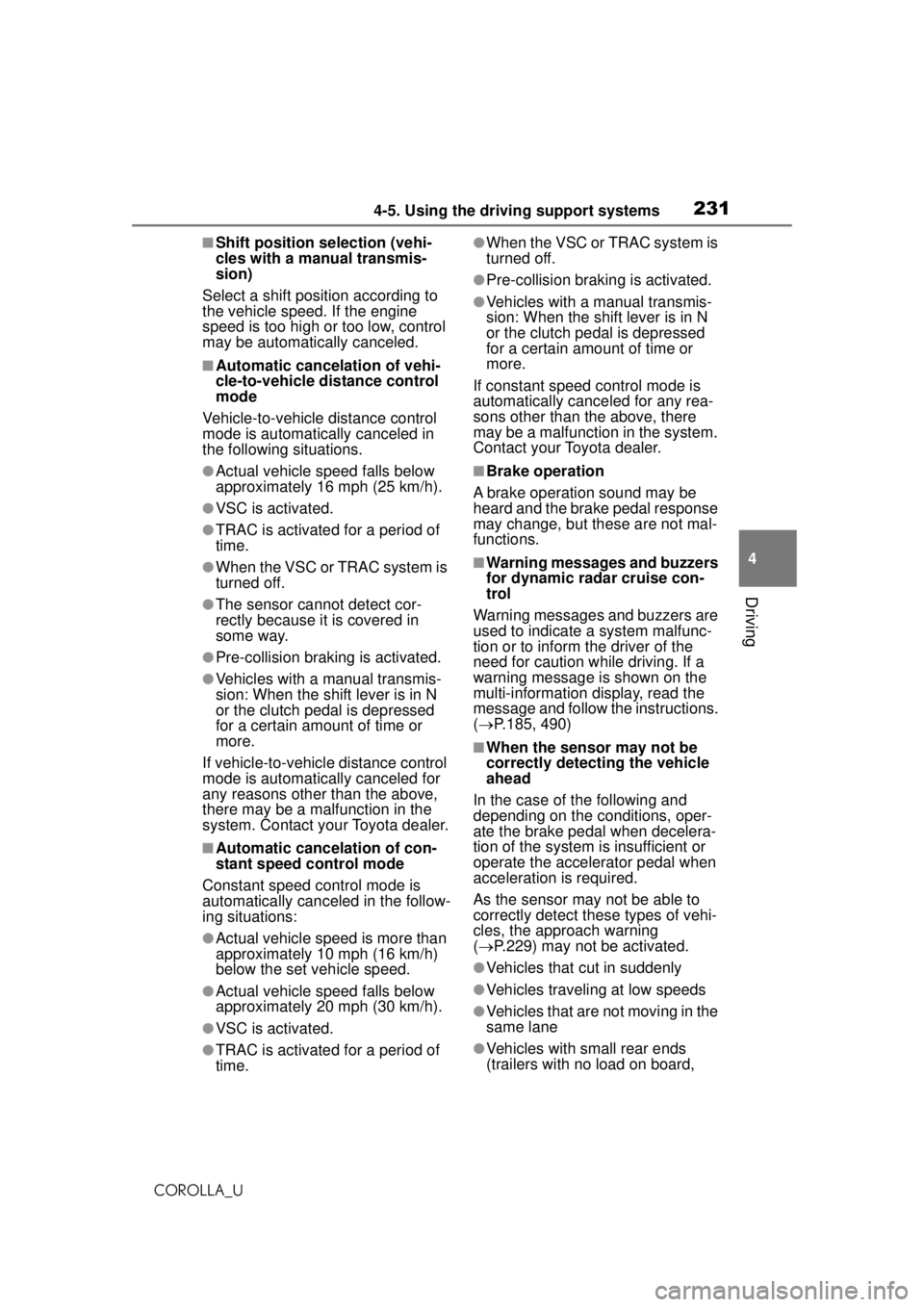
2314-5. Using the driving support systems
COROLLA_U
4
Driving
‚Ė†Shift position selection (vehi-
cles with a manual transmis-
sion)
Select a shift position according to
the vehicle speed. If the engine
speed is too high or too low, control
may be automatically canceled.
‚Ė†Automatic cancelation of vehi-
cle-to-vehicle distance control
mode
Vehicle-to-vehicle distance control
mode is automatically canceled in
the following situations.
‚óŹActual vehicle speed falls below
approximately 16 mph (25 km/h).
‚óŹVSC is activated.
‚óŹTRAC is activated for a period of
time.
‚óŹWhen the VSC or TRAC system is
turned off.
‚óŹThe sensor cannot detect cor-
rectly because it is covered in
some way.
‚óŹPre-collision brakin g is activated.
‚óŹVehicles with a manual transmis-
sion: When the shift lever is in N
or the clutch pedal is depressed
for a certain amount of time or
more.
If vehicle-to-vehicle distance control
mode is automatically canceled for
any reasons other than the above,
there may be a malfunction in the
system. Contact your Toyota dealer.
‚Ė†Automatic cancelation of con-
stant speed control mode
Constant speed control mode is
automatically canceled in the follow-
ing situations:
‚óŹActual vehicle speed is more than
approximately 10 mph (16 km/h)
below the set vehicle speed.
‚óŹActual vehicle speed falls below
approximately 20 mph (30 km/h).
‚óŹVSC is activated.
‚óŹTRAC is activated for a period of
time.
‚óŹWhen the VSC or TRAC system is
turned off.
‚óŹPre-collision braking is activated.
‚óŹVehicles with a manual transmis-
sion: When the shift lever is in N
or the clutch pedal is depressed
for a certain amount of time or
more.
If constant speed control mode is
automatically canceled for any rea-
sons other than the above, there
may be a malfunction in the system.
Contact your Toyota dealer.
‚Ė†Brake operation
A brake operation sound may be
heard and the brake pedal response
may change, but these are not mal-
functions.
‚Ė†Warning messages and buzzers
for dynamic radar cruise con-
trol
Warning messages and buzzers are
used to indicate a system malfunc-
tion or to inform the driver of the
need for caution while driving. If a
warning message is shown on the
multi-information di splay, read the
message and follow the instructions.
( Ôāģ P.185, 490)
‚Ė†When the sensor may not be
correctly detecting the vehicle
ahead
In the case of the following and
depending on the conditions, oper-
ate the brake pedal when decelera-
tion of the system is insufficient or
operate the accelerator pedal when
acceleration is required.
As the sensor may not be able to
correctly detect these types of vehi-
cles, the approach warning
( Ôāģ P.229) may not be activated.
‚óŹVehicles that cut in suddenly
‚óŹVehicles traveling at low speeds
‚óŹVehicles that are not moving in the
same lane
‚óŹVehicles with small rear ends
(trailers with no load on board,
Page 232 of 588
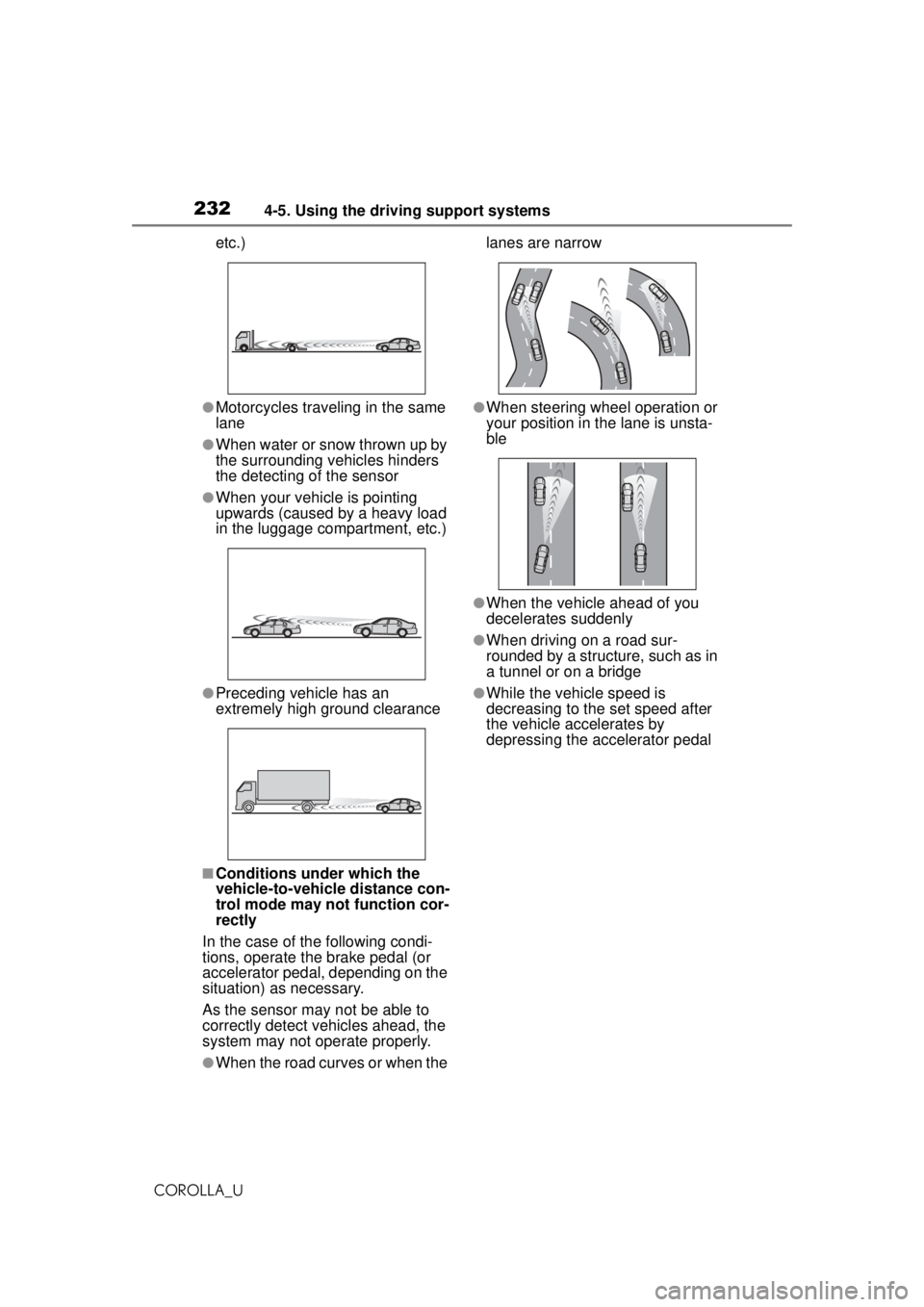
2324-5. Using the driving support systems
COROLLA_Uetc.)
‚óŹMotorcycles traveling in the same
lane
‚óŹWhen water or snow thrown up by
the surrounding vehicles hinders
the detecting of the sensor
‚óŹWhen your vehicle is pointing
upwards (caused by a heavy load
in the luggage compartment, etc.)
‚óŹPreceding vehicle has an
extremely high ground clearance
‚Ė†Conditions under which the
vehicle-to-vehicle distance con-
trol mode may not function cor-
rectly
In the case of the following condi-
tions, operate the brake pedal (or
accelerator pedal, depending on the
situation) as necessary.
As the sensor may not be able to
correctly detect vehicles ahead, the
system may not operate properly.
‚óŹWhen the road curves or when the lanes are narrow
‚óŹWhen steering wheel operation or
your position in the lane is unsta-
ble
‚óŹWhen the vehicle ahead of you
decelerates suddenly
‚óŹWhen driving on a road sur-
rounded by a structure, such as in
a tunnel or on a bridge
‚óŹWhile the vehicle speed is
decreasing to the set speed after
the vehicle accelerates by
depressing the accelerator pedal
Page 233 of 588
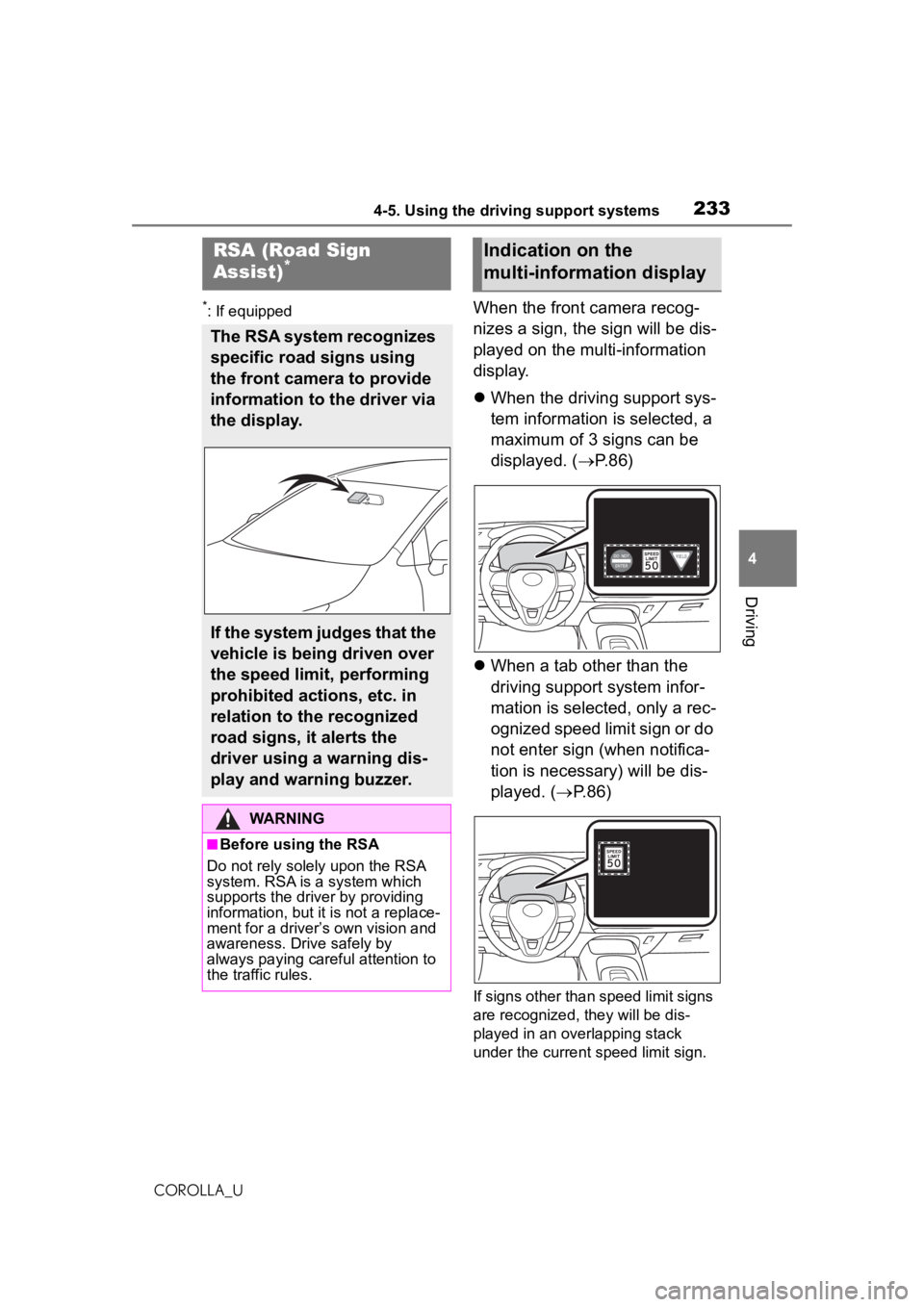
2334-5. Using the driving support systems
COROLLA_U
4
Driving
*: If equippedWhen the front camera recog-
nizes a sign, the sign will be dis-
played on the multi-information
display.
ÔĀ¨ When the driving support sys-
tem information is selected, a
maximum of 3 signs can be
displayed. (Ôāģ P.86)
ÔĀ¨ When a tab other than the
driving support system infor-
mation is selected, only a rec-
ognized speed limit sign or do
not enter sign (when notifica-
tion is necessary) will be dis-
played. (Ôāģ P.86)
If signs other than speed limit signs
are recognized, they will be dis-
played in an overlapping stack
under the current speed limit sign.
RSA (Road Sign
Assist)*
The RSA system recognizes
specific road signs using
the front camera to provide
information to the driver via
the display.
If the system judges that the
vehicle is being driven over
the speed limit, performing
prohibited actions, etc. in
relation to the recognized
road signs, it alerts the
driver using a warning dis-
play and warning buzzer.
WARNING
‚Ė†Before using the RSA
Do not rely solely upon the RSA
system. RSA is a system which
supports the driver by providing
information, but it is not a replace-
ment for a driver’s own vision and
awareness. Drive safely by
always paying careful attention to
the traffic rules.
Indication on the
multi-information display
Page 234 of 588
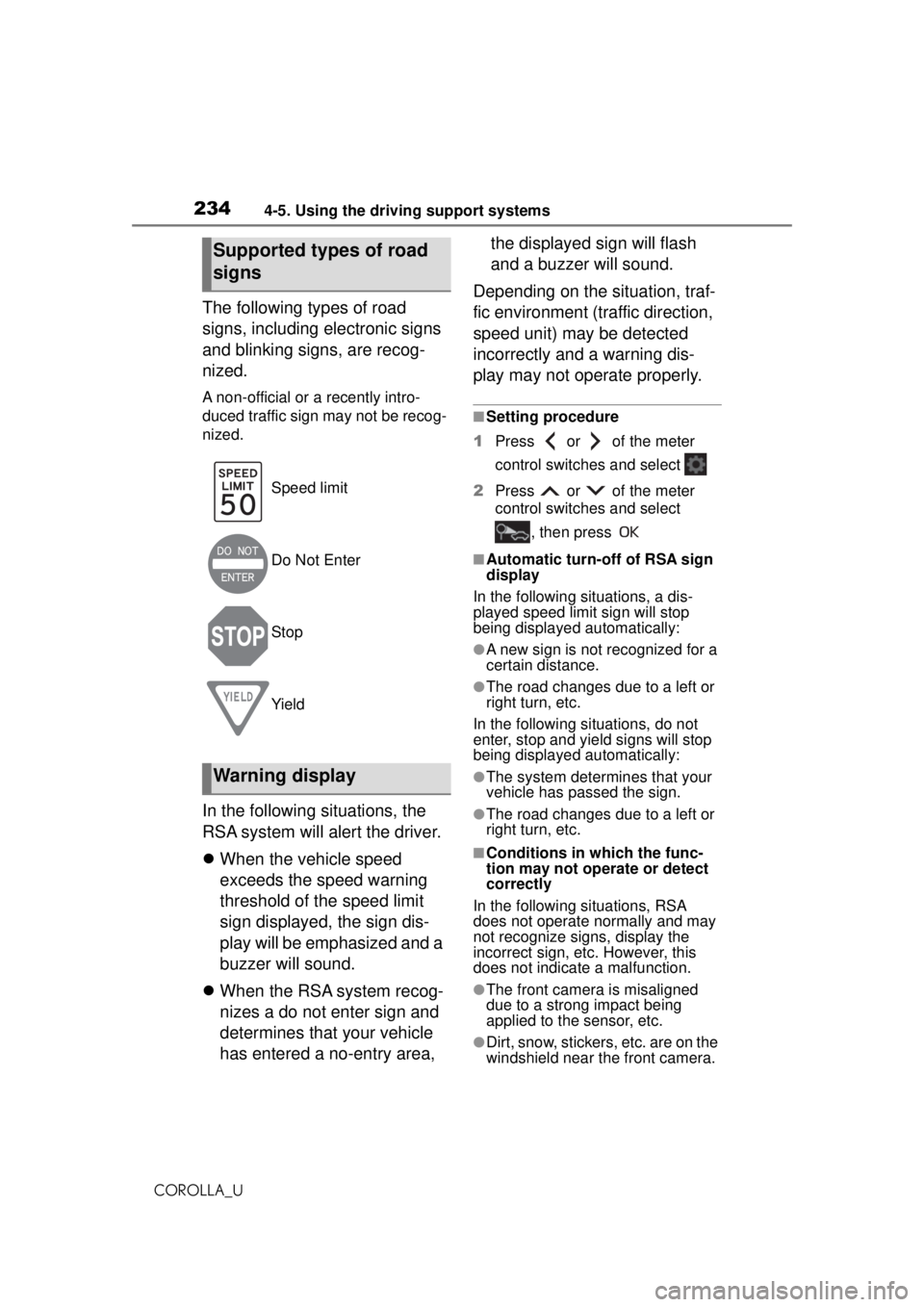
2344-5. Using the driving support systems
COROLLA_U
The following types of road
signs, including electronic signs
and blinking signs, are recog-
nized.
A non-official or a recently intro-
duced traffic sign may not be recog-
nized.
In the following situations, the
RSA system will alert the driver.
ÔĀ¨When the vehicle speed
exceeds the speed warning
threshold of the speed limit
sign displayed, the sign dis-
play will be emphasized and a
buzzer will sound.
ÔĀ¨ When the RSA system recog-
nizes a do not enter sign and
determines that your vehicle
has entered a no-entry area, the displayed sign will flash
and a buzzer will sound.
Depending on the situation, traf-
fic environment (traffic direction,
speed unit) may be detected
incorrectly and a warning dis-
play may not operate properly.
‚Ė†Setting procedure
1 Press or of the meter
control switches and select
2 Press or of the meter
control switches and select
, then press
‚Ė†Automatic turn-off of RSA sign
display
In the following situations, a dis-
played speed limit sign will stop
being displayed automatically:
‚óŹA new sign is not recognized for a
certain distance.
‚óŹThe road changes due to a left or
right turn, etc.
In the following situations, do not
enter, stop and yield signs will stop
being displayed automatically:
‚óŹThe system determines that your
vehicle has passed the sign.
‚óŹThe road changes due to a left or
right turn, etc.
‚Ė†Conditions in which the func-
tion may not operate or detect
correctly
In the following situations, RSA
does not operate normally and may
not recognize signs, display the
incorrect sign, etc. However, this
does not indicate a malfunction.
‚óŹThe front camera is misaligned
due to a strong impact being
applied to the sensor, etc.
‚óŹDirt, snow, stickers, etc. are on the
windshield near the front camera.
Supported types of road
signs
Speed limit
Do Not Enter
Stop
Yield
Warning display
Page 235 of 588
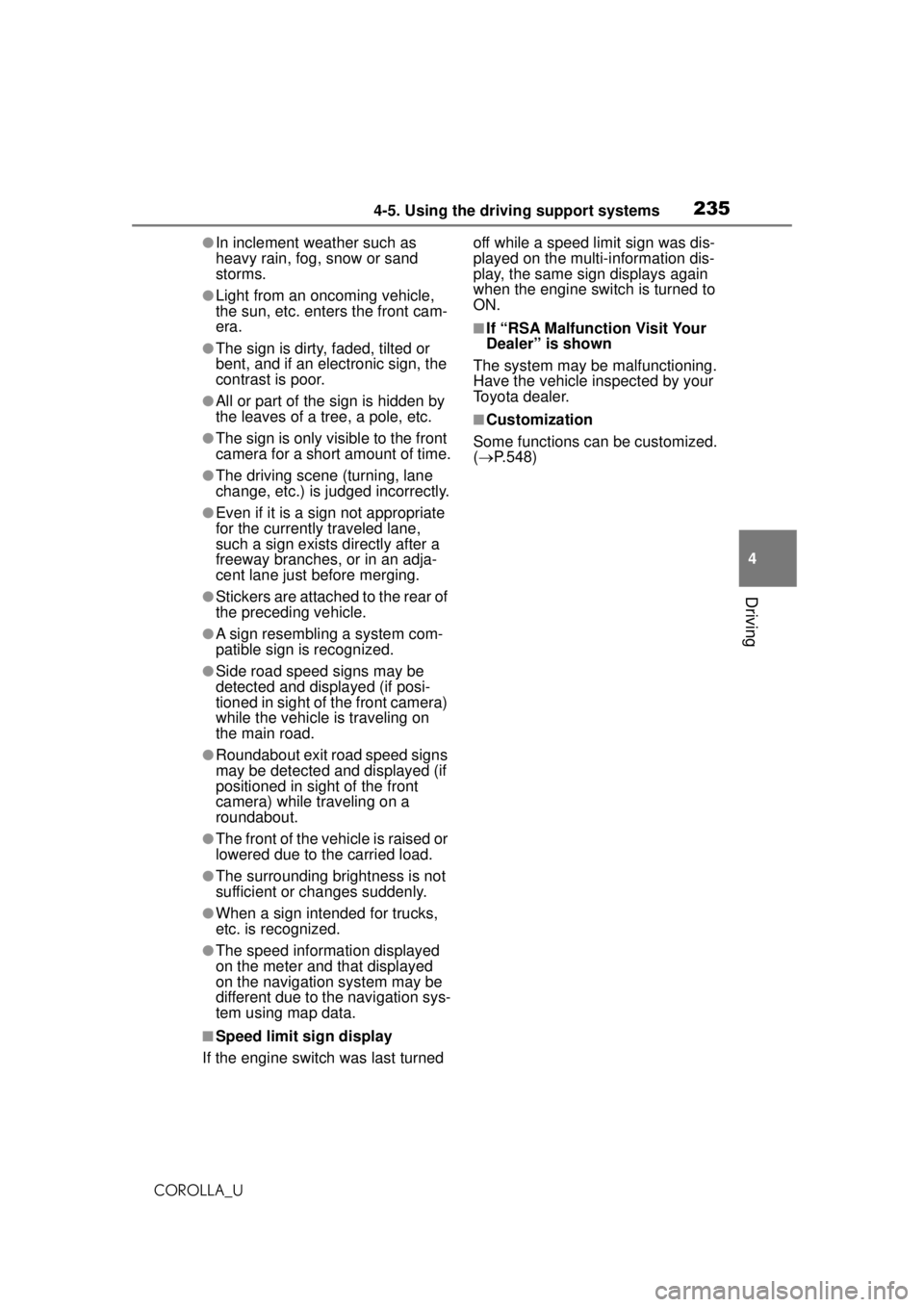
2354-5. Using the driving support systems
COROLLA_U
4
Driving
‚óŹIn inclement weather such as
heavy rain, fog, snow or sand
storms.
‚óŹLight from an oncoming vehicle,
the sun, etc. enters the front cam-
era.
‚óŹThe sign is dirty, faded, tilted or
bent, and if an electronic sign, the
contrast is poor.
‚óŹAll or part of the sign is hidden by
the leaves of a tree, a pole, etc.
‚óŹThe sign is only visible to the front
camera for a short amount of time.
‚óŹThe driving scene (turning, lane
change, etc.) is judged incorrectly.
‚óŹEven if it is a sign not appropriate
for the currently traveled lane,
such a sign exists directly after a
freeway branches, or in an adja-
cent lane just before merging.
‚óŹStickers are attached to the rear of
the preceding vehicle.
‚óŹA sign resembling a system com-
patible sign is recognized.
‚óŹSide road speed signs may be
detected and displayed (if posi-
tioned in sight of the front camera)
while the vehicle is traveling on
the main road.
‚óŹRoundabout exit road speed signs
may be detected and displayed (if
positioned in sight of the front
camera) while traveling on a
roundabout.
‚óŹThe front of the vehicle is raised or
lowered due to the carried load.
‚óŹThe surrounding brightness is not
sufficient or changes suddenly.
‚óŹWhen a sign intended for trucks,
etc. is recognized.
‚óŹThe speed information displayed
on the meter and that displayed
on the navigation system may be
different due to the navigation sys-
tem using map data.
‚Ė†Speed limit sign display
If the engine switch was last turned off while a speed limit sign was dis-
played on the multi-information dis-
play, the same sign displays again
when the engine switch is turned to
ON.
‚Ė†If ‚ÄúRSA Malfunction Visit Your
Dealer‚ÄĚ is shown
The system may be malfunctioning.
Have the vehicle inspected by your
Toyota dealer.
‚Ė†Customization
Some functions can be customized.
( Ôāģ P.548)
Page 236 of 588
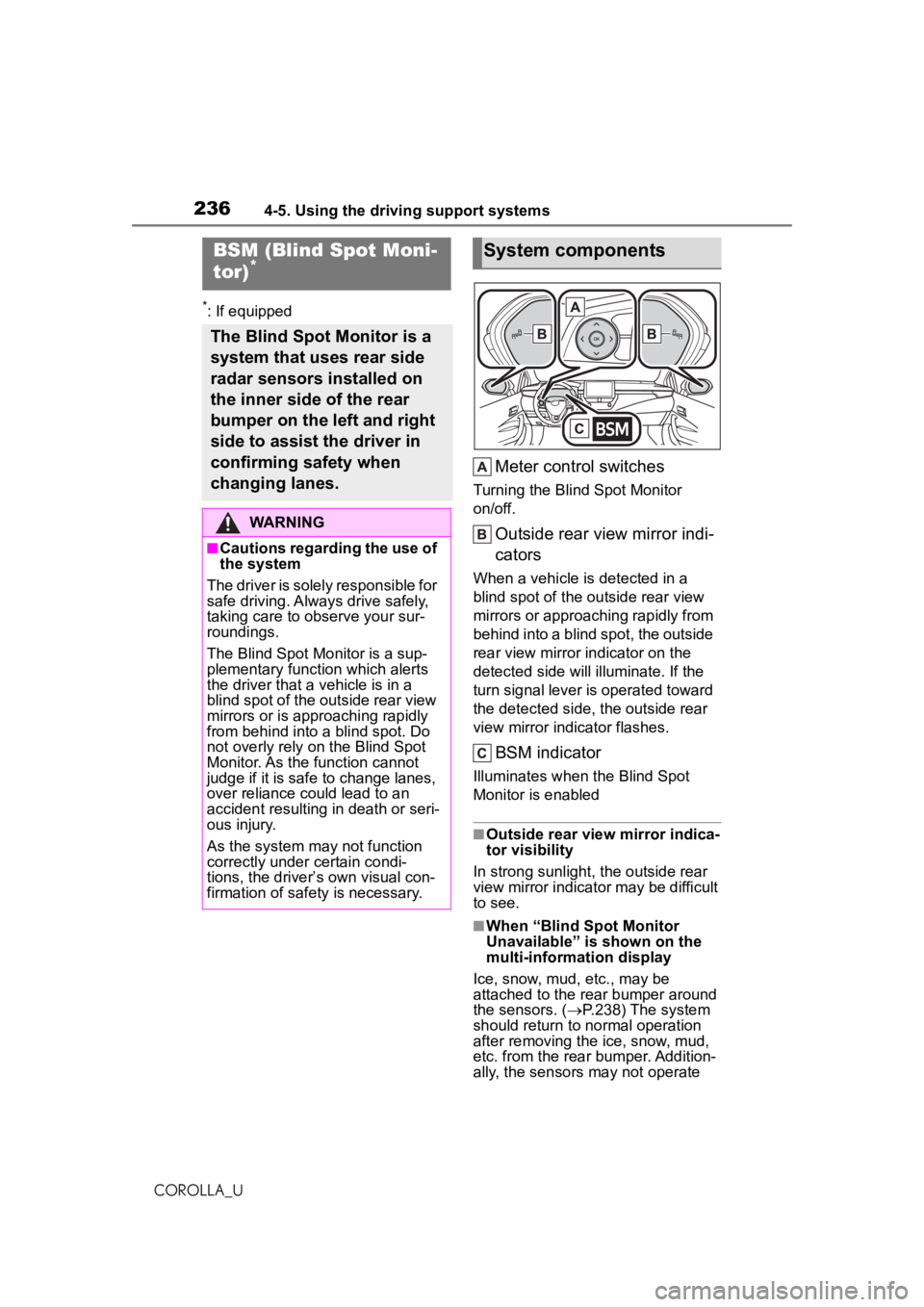
2364-5. Using the driving support systems
COROLLA_U
*: If equipped
Meter control switches
Turning the Blind Spot Monitor
on/off.
Outside rear view mirror indi-
cators
When a vehicle is detected in a
blind spot of the outside rear view
mirrors or approaching rapidly from
behind into a blind spot, the outside
rear view mirror indicator on the
detected side will illuminate. If the
turn signal lever is operated toward
the detected side, the outside rear
view mirror indicator flashes.
BSM indicator
Illuminates when the Blind Spot
Monitor is enabled
‚Ė†Outside rear view mirror indica-
tor visibility
In strong sunlight, the outside rear
view mirror indicator may be difficult
to see.
‚Ė†When ‚ÄúBlind Spot Monitor
Unavailable‚ÄĚ is shown on the
multi-information display
Ice, snow, mud, etc., may be
attached to the rear bumper around
the sensors. ( ÔāģP.238) The system
should return to normal operation
after removing the ice, snow, mud,
etc. from the rear bumper. Addition-
ally, the sensors may not operate
BSM (Blind Spot Moni-
tor)*
The Blind Spot Monitor is a
system that uses rear side
radar sensors installed on
the inner side of the rear
bumper on the left and right
side to assist the driver in
confirming safety when
changing lanes.
WARNING
‚Ė†Cautions regarding the use of
the system
The driver is solely responsible for
safe driving. A lways drive safely,
taking care to observe your sur-
roundings.
The Blind Spot Monitor is a sup-
plementary function which alerts
the driver that a vehicle is in a
blind spot of the outside rear view
mirrors or is approaching rapidly
from behind into a blind spot. Do
not overly rely on the Blind Spot
Monitor. As the function cannot
judge if it is safe to change lanes,
over reliance could lead to an
accident resulting in death or seri-
ous injury.
As the system may not function
correctly under certain condi-
tions, the driver’s own visual con-
firmation of safety is necessary.
System components
Page 237 of 588
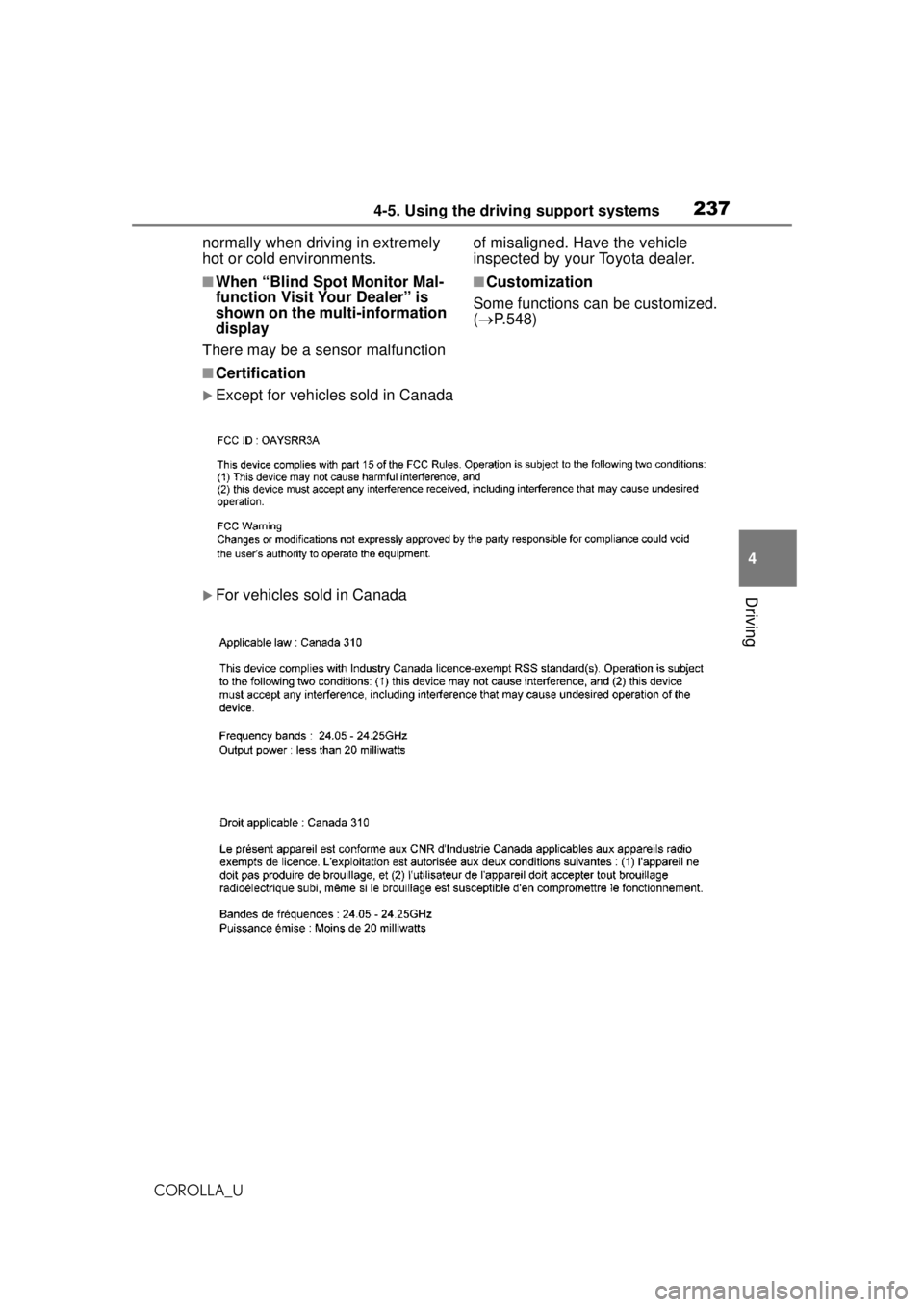
2374-5. Using the driving support systems
COROLLA_U
4
Driving
normally when driving in extremely
hot or cold environments.
‚Ė†When ‚ÄúBlind Spot Monitor Mal-
function Visit Your Dealer‚ÄĚ is
shown on the multi-information
display
There may be a sensor malfunction of misaligned. Have the vehicle
inspected by your Toyota dealer.‚Ė†Customization
Some functions can be customized.
( Ôāģ P.548)
‚Ė†Certification
ÔĀĶExcept for vehicles sold in Canada
ÔĀĶFor vehicles sold in Canada
Page 238 of 588
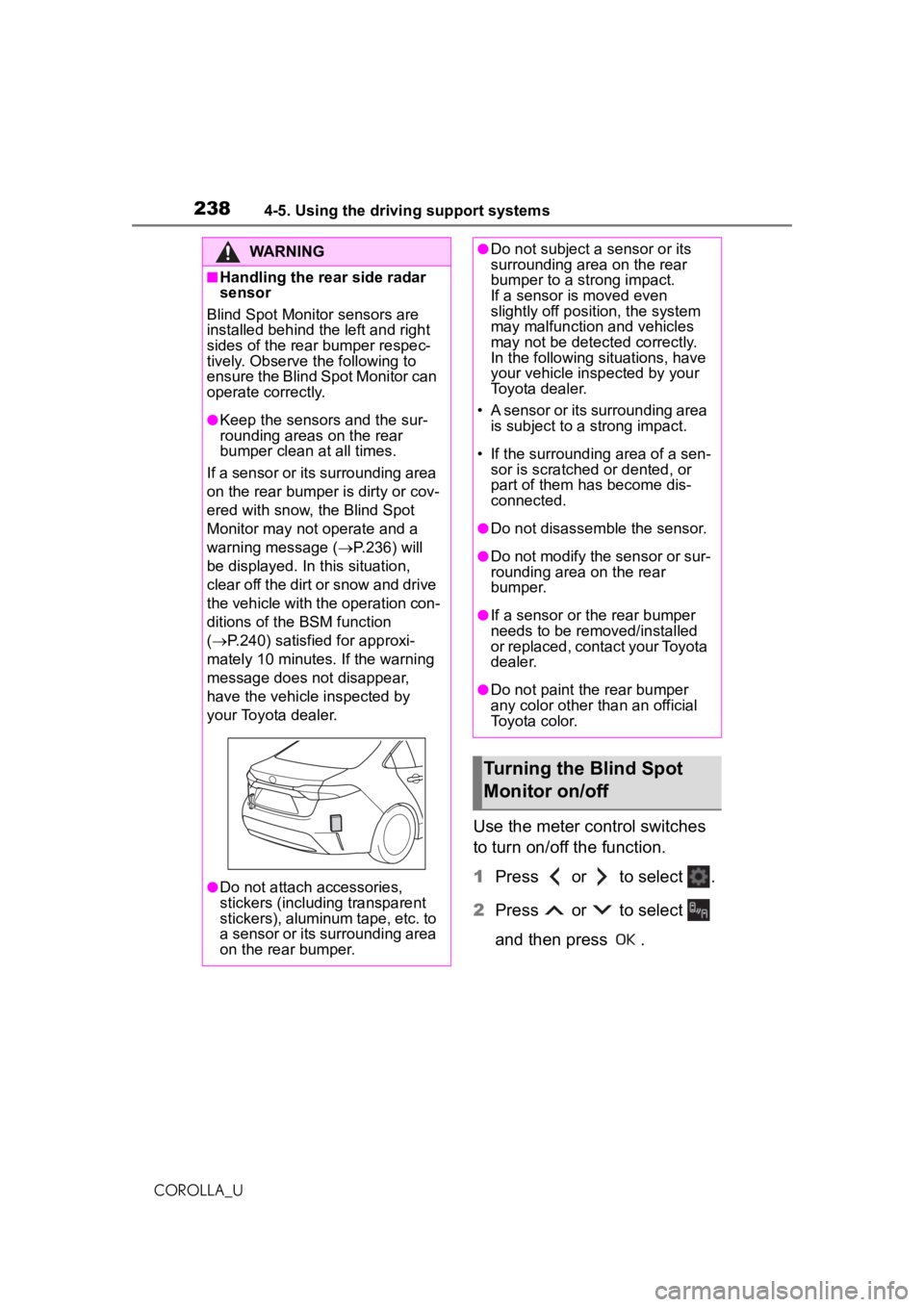
2384-5. Using the driving support systems
COROLLA_U
Use the meter control switches
to turn on/off the function.
1Press or to select .
2 Press or to select
and then press .
WARNING
‚Ė†Handling the rear side radar
sensor
Blind Spot Monitor sensors are
installed behind the left and right
sides of the rear bumper respec-
tively. Observe the following to
ensure the Blind Spot Monitor can
operate correctly.
‚óŹKeep the sensors and the sur-
rounding areas on the rear
bumper clean at all times.
If a sensor or its surrounding area
on the rear bumper is dirty or cov-
ered with snow, the Blind Spot
Monitor may not operate and a
warning message (Ôāģ P.236) will
be displayed. In this situation,
clear off the dirt or snow and drive
the vehicle with the operation con-
ditions of the BSM function
( Ôāģ P.240) satisfied for approxi-
mately 10 minutes. If the warning
message does not disappear,
have the vehicle inspected by
your Toyota dealer.
‚óŹDo not attach accessories,
stickers (including transparent
stickers), aluminum tape, etc. to
a sensor or its surrounding area
on the rear bumper.
‚óŹDo not subject a sensor or its
surrounding area on the rear
bumper to a strong impact.
If a sensor is moved even
slightly off position, the system
may malfunction and vehicles
may not be detected correctly.
In the following si tuations, have
your vehicle inspected by your
Toyota dealer.
‚ÄĘ A sensor or its surrounding area is subject to a strong impact.
‚ÄĘ If the surrounding area of a sen- sor is scratched or dented, or
part of them has become dis-
connected.
‚óŹDo not disassemble the sensor.
‚óŹDo not modify the sensor or sur-
rounding area on the rear
bumper.
‚óŹIf a sensor or the rear bumper
needs to be removed/installed
or replaced, contact your Toyota
dealer.
‚óŹDo not paint the rear bumper
any color other than an official
Toyota color.
Turning the Blind Spot
Monitor on/off
Page 239 of 588
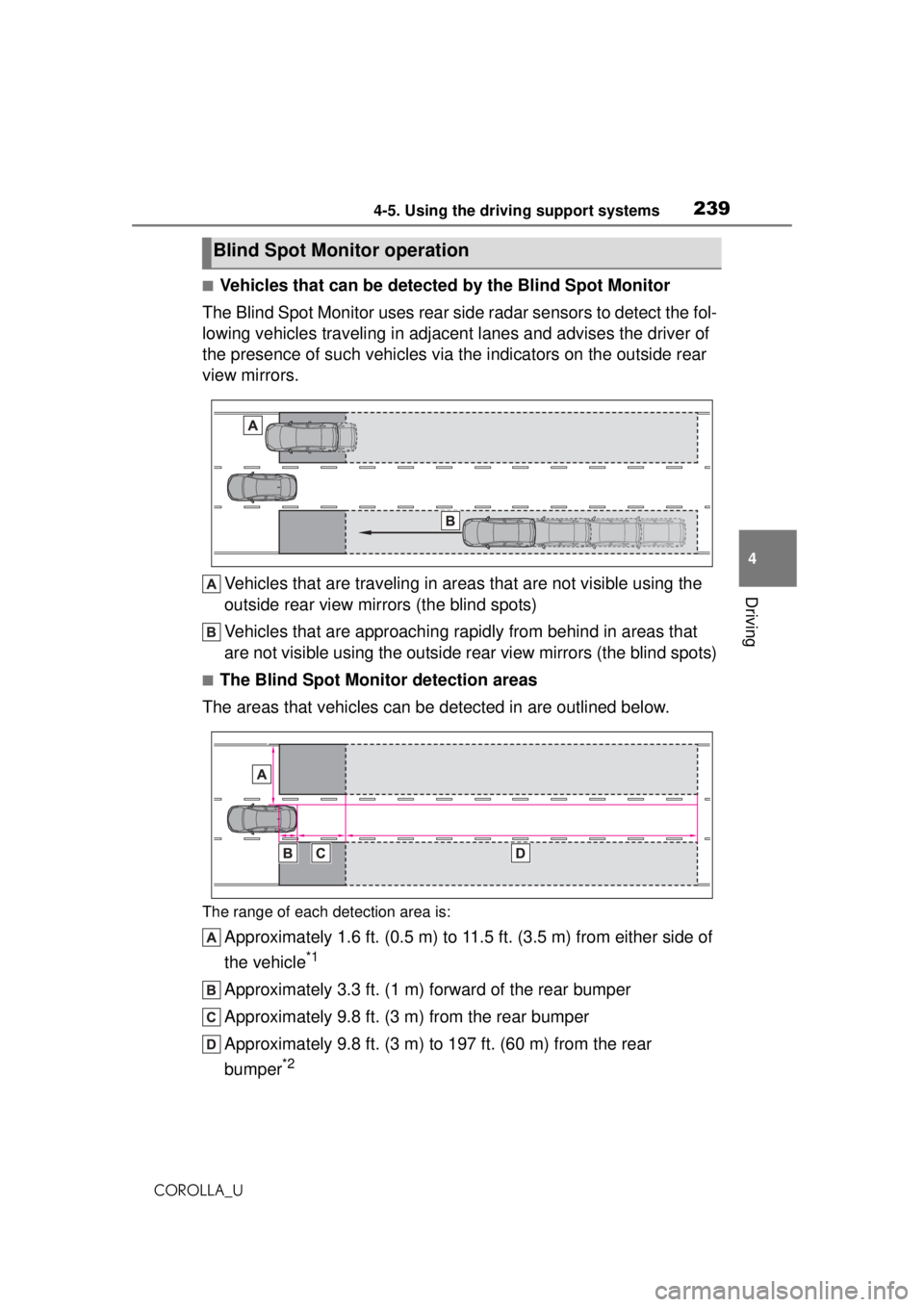
2394-5. Using the driving support systems
COROLLA_U
4
Driving
‚Ė†Vehicles that can be detected by the Blind Spot Monitor
The Blind Spot Monitor uses rear si de radar sensors to detect the fol-
lowing vehicles traveling in adjacent lanes and advises the driver of
the presence of such vehicles via the indicators on the outside rear
view mirrors.
Vehicles that are traveling in areas that are not visible using the
outside rear view mirrors (the blind spots)
Vehicles that are approaching r apidly from behind in areas that
are not visible using the outside rear view mirrors (the blind spots)
‚Ė†The Blind Spot Monitor detection areas
The areas that vehicles can be detected in are outlined below.
The range of each detection area is:
Approximately 1.6 ft. (0.5 m) to 11.5 ft. (3.5 m) from either side of
the vehicle
*1
Approximately 3.3 ft. (1 m) forward of the rear bumper
Approximately 9.8 ft. (3 m) from the rear bumper
Approximately 9.8 ft. (3 m) to 197 ft. (60 m) from the rear
bumper
*2
Blind Spot Monitor operation
Page 240 of 588

2404-5. Using the driving support systems
COROLLA_U
*1: The area between the side of the vehicle and 1.6 ft. (0.5 m) from the side
of the vehicle cannot be detected.
*2: The greater the difference in speed between your vehicle and the detected vehicle is, the fa rther away the vehicle will be detected, causing
the outside rear view mirror indicator to illuminate or flash.
‚Ė†The Blind Spot Monitor is oper-
ational when
The Blind Spot Monitor is opera-
tional when all of the following con-
ditions are met:
‚óŹThe Blind Spot Monitor is on.
‚óŹThe shift lever is in a position
other than R.
‚óŹThe vehicle speed is greater than
approximately 10 mph (16 km/h).
‚Ė†The Blind Spot Monitor will
detect a vehicle when
The Blind Spot Monitor will detect a
vehicle present in the detection area
in the following situations:
‚óŹA vehicle in an adjacent lane over-
takes your vehicle.
‚óŹYou overtake a vehicle in adjacent
lane slowly.
‚óŹAnother vehicle enters the detec-
tion area when it changes lanes.
‚Ė†Conditions under which the
Blind Spot Monitor will not
detect a vehicle
The Blind Spot Monitor is not
designed to detect the following
types of vehicles and/or objects:
‚óŹSmall motorcycles, bicycles,
pedestrians, etc.*
‚óŹVehicles traveling in the opposite
direction
‚óŹGuardrails, walls, signs, parked
vehicles and similar stationary
objects
*
‚óŹFollowing vehicles that are in the
same lane*
‚óŹVehicles traveling 2 lanes away
from your vehicle*
‚óŹVehicles which are being over-
taken rapidly by your vehicle*
*
: Depending on the conditions, detection of a vehicle and/or
object may occur.
‚Ė†Conditions under which the
Blind Spot Monitor may not
function correctly
‚óŹThe Blind Spot Monitor may not
detect vehicles correctly in the fol-
lowing situations:
‚ÄĘ When the sensor is misaligned
due to a strong impact to the sen-
sor or its surrounding area
‚ÄĘ When mud, snow, ice, a sticker,
etc. is covering the sensor or sur-
rounding area on the rear bumper
‚ÄĘ When driving on a road surface
that is wet with standing water
during bad weather, such as
heavy rain, snow, or fog
‚ÄĘ When multiple vehicles are
approaching with only a small gap
between each vehicle
‚ÄĘ When the distance between your
vehicle and a following vehicle is
short
‚ÄĘ When there is a significant differ-
ence in speed between your vehi-
cle and the vehicle that enters the
detection area
‚ÄĘ When the difference in speed between your vehicle and another
vehicle is changing
‚ÄĘ When a vehicle enters a detection area traveling at about the same
speed as your vehicle
‚ÄĘ As your vehicle starts from a stop, a vehicle remains in the detection
area
‚ÄĘ When driving up and down con- secutive steep inclines, such as
hills, dips in the road, etc.
‚ÄĘ When driving on roads with sharp bends, consecutive curves, or